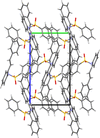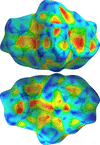issue contents
October 2024 issue

Cover illustration: The search for organic materials for non-linear optical and semiconducting applications continues to attract a great deal of attention. Organic compounds are highly versatile low-cost materials that can be easily derivatized using well-established synthetic techniques. In this issue, Filley [Acta Cryst. (2024). E80, 1003–1005] presents the structure of 2-methoxy-5-nitroaniline, which displays concentration-dependent change in absorption wavelength resulting from charge transfer due to an anti-parallel stacking of the strong dipole moments.
editorial
This virtual collection is a celebration. It is a celebration of crystallography in Africa, and a celebration of the international crystallography community. It commemorates the founding of the African Crystallographic Association (AfCA), which was accepted as the newest Regional Associate of the International Union of Crystallography (IUCr) in 2023, the year of the 75th anniversary of the first IUCr Congress and General Assembly. The collection contains research articles authored by scientists across the African continent, as well as a selection of articles giving context to crystallography in Africa. These discuss history, collaboration between scientists and between associations, and various educational and outreach initiatives.
research communications
Download citation


Download citation


The asymmetric unit of the title salt comprises two 1,3-dihydro-2H-benzimidazol-2-iminium cations and two 2-hydroxy-5-sulfobenzoate anions (Z′ = 2). In the crystal, the molecules interact through N—H⋯O, O—H⋯O hydrogen bonds and C—O⋯π contacts. The hydrogen-bonding interactions lead to the formation of layers parallel to (![[\overline{1}]](/e/issues/2024/10/00/wm5724/teximages/wm5724fi1.svg) 01).
01).
CCDC reference: 2380553
Download citation


Download citation


The title compound 2-methoxy-5-nitroaniline forms orange–red crystals and displays shifts in light absorption to longer wavelengths in solution as the concentration increases. Molecular face-to-face stacking with dipoles oriented antiparallel creates a color center, which is compared to certain inorganic semiconductors.
CCDC reference: 2382128
Download citation


Download citation


Crystals of tris[(6-bromopyridin-2-yl)methyl]amine (TPABr3) were obtained from a solution in acetonitrile upon evaporation. The crystals are triclinic with space group P![[\overline{1}]](/e/issues/2024/10/00/ev2008/teximages/ev2008fi1.svg) .
.
CCDC reference: 2381692
Download citation


Download citation


The molecules of the title compound are linked by weak C—H⋯O and C—H⋯π interactions.
CCDC reference: 2380701
Download citation


Download citation


In the title compound, C23H24N2O2S, the two molecules in the asymmetric unit have a structural overlap with an r.m.s. deviation of 0.82 Å.
CCDC reference: 2380151
Download citation


Download citation


An analysis of the complex structure obtained by crystallization of 5-nonanoyl-8-hydroxyquinoline and InCl3 in acetonitrile is reported.
CCDC reference: 2382976
Download citation


Download citation


The structure of a new selenodiazolium salt derived from the reaction between 2-pyridylselenyl chloride and phenylselenocyanate is described. Halogen–hydrogen, chalcogen–chalcogen, chalcogen–hydrogen and chalcogen–halogen interactions are present in the structure.
CCDC reference: 2382988
Download citation


Download citation


In the crystal structure of the title compound, the CoII cations are octahedrally coordinated by two bridging and one terminal thiocyanate anions, two bridging 4-methylpyridine N-oxide coligands and one ethanol molecule and linked into chains by single μ-1,3-bridging anionic ligands that are further connected into layers by pairs of μ-1,1(O,O)-bridging 4-methylpyridine N-oxide coligands.
CCDC reference: 2384436
Download citation


Download citation


The crystal structure of the title compound C20H17NO2S features hydrogen-bonding and C—H⋯π. Docking studies show that it has a strong binding affinity with EGFR kinase, indicating its potential as a promising candidate for targeted lung cancer therapy.
CCDC reference: 2364967
Download citation


Download citation


The title compound, which was obtained by the reaction between 1,10-phenanthroline and phenyltin trichloride in methanol, exhibits intramolecular interactions involving the chlorine and hydrogen atoms. Crystal cohesion is ensured by intermolecular C—H⋯Cl hydrogen bonds, as well as Y—X⋯π and π-stacking interactions
CCDC reference: 2370790
Download citation


Download citation


The structure of the title 1–1′-binaphthyl derivative was refined with non-spherical atomic form factors computed using the DFT method at the PBE0/def2-TZVP basis set level.
CCDC reference: 2384706
Download citation


Download citation


8-Hydroxyquinolinium trichlorido(pyridine-2,6-dicarboxylic acid-κ3O,N,O′)copper(II) dihydrate
The title compound, (C9H8NO)[CuCl3(C7H5NO4)]·2H2O, was synthesized by reacting CuII acetate, 8-hydroxyquinoline, and pyridine-2,6-dicarboxylic acid in dilute hydrochloric acid in a 1:1:1 molar ratio. The CuII atom exhibits a distorted octahedral geometry coordinated by the H2pydc ligand and chloride atoms. In the crystal structure, various hydrogen bonds and weak interactions lead to the formation of a three-dimensional network.
CCDC reference: 2307012
Download citation


Download citation


The title complex, which consists of a central zinc metal ion surrounded by six 1-methylimidazole ligands, charge balanced by two nitrate anions and which crystallizes in the space group P![[\overline{3}]](/e/issues/2024/10/00/yy2011/teximages/yy2011fi1.svg) has been synthesized and its structure determined.
has been synthesized and its structure determined.
CCDC reference: 2270103
Download citation


Download citation


In the crystal structure of the title compound, the copper cations are each tetrahedrally coordinated by two 2–3-dimethylpyrazine ligands and two chloride anions and linked into dinuclear units that are further connected into layers by bridging 2,3-dimethylpyrazine ligands.
CCDC reference: 2385254
Download citation


Download citation


The title molecular salt was prepared by the reaction of sulfamethoxazole and H2SO4 in methanol and crystallized from methanol–ether–water. Protonation takes place at the nitrogen atom of the primary amino group. In the crystal, N—H⋯O hydrogen bonds (water and methylsulfate anion) and intermolecular N—H⋯N interactions involving the sulfonamide and isoxazole nitrogen atoms, link the components into a tri-dimensional network, which also features face-to-face π–π interactions between the phenyl rings of adjacent molecules.
CCDC reference: 2385280
Download citation


Download citation


The crystal structure of an A1/A2-bromobutoxy-hydroxy difunctionalized pillar[5]arene that encapsulates an adiponitrile molecule in its cavity is reported and the supramolecular features of this inclusion complex are discussed.
CCDC reference: 2357919
Download citation


Download citation


In the title molecule, the benzimidazole moiety is oriented almost perpendicular to the triazole ring. In the crystal, C—H⋯O hydrogen bonds link the molecules into a network structure.
CCDC reference: 2381865
Download citation


Download citation


A mononuclear cadmium(II) complex [CdLCl], where HL = 2-[bis(pyridin-2-ylmethyl)amino]ethane-1-thiol, was synthesized and characterized by single-crystal X-ray diffraction and Hirshfeld analysis.
CCDC reference: 2385270
Download citation


Download citation


The ligands at the AuI atoms are antiperiplanar to each other across the S⋯S vectors. Residues are linked by various contacts of the types C—H⋯X, E⋯X and Br⋯Br.
Download citation


Download citation


The packing of the title hydrated molecular salt features an unusual O—H⋯π interaction.
CCDC reference: 2314756
Download citation


Download citation


Phosphinito and phosphinomethyl ligands incorporating an anthraquinone moiety were reacted with bis(cycloocta-1,5-diene)diiridium(I) dichloride to afford novel diiridium species. Intended as pincer-type tridentate ligands, bidentate binding modes were determined by X-ray crystallography. The anionic μ-trichlorido phosphinito complex formed is charged-balanced by one [Ir(toluene)(cycloocta-1,5-diene)]+ per asymmetric unit, the structure of which has not previously been reported despite a long history of use as an IrI source in organometallic chemistry.

 journal menu
journal menu










































